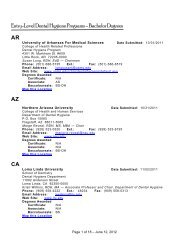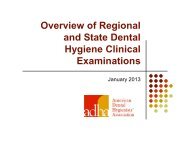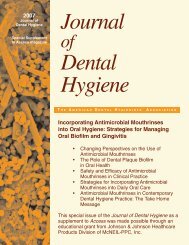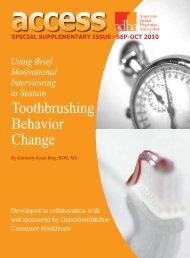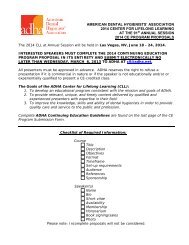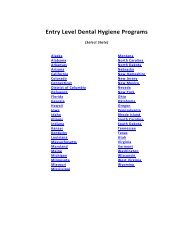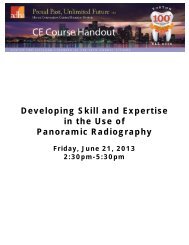Relationship Between Oral Health and Systemic Disease - American ...
Relationship Between Oral Health and Systemic Disease - American ...
Relationship Between Oral Health and Systemic Disease - American ...
Create successful ePaper yourself
Turn your PDF publications into a flip-book with our unique Google optimized e-Paper software.
Inflammatory mediators, such ascytokines produced by the periodontium,may be another mechanism bywhich respiratory disease are associatedwith oral health. These mediators presentin inflamed gingival tissues enter thegingival crevicular fluid <strong>and</strong> then thesaliva. Once aspirated, these mediatorscan have proinflammatory effects in thelower airway.Further, studies have demonstratedthat periodontal diseases have beenshown to increase the risk of adversepregnancy outcomes such as prematurebirth <strong>and</strong> low birth weight. 39-41 Uterinecontractions are stimulated by oxytocin,which is produced by the hypothalamus,<strong>and</strong> by prostagl<strong>and</strong>ins produced by theplacenta. This process normally occursin the third trimester <strong>and</strong> leads to birth.However, chronic infection can stimulatethe inflammatory process, whichleads to elevated amniotic levels ofprostagl<strong>and</strong>ins, TNF-α, <strong>and</strong> IL-1 <strong>and</strong>IL-6. These mediators then lead to prematurerupture of membranes <strong>and</strong>preterm labor. Other work has suggestedthat periodontal pathogens may travelfrom the gingival sulcus to the placenta<strong>and</strong> stimulate preterm birth. Specifically, Han <strong>and</strong> colleaguesfound that periodontal bacteria, including Fusobacteriumnucleatum, entered the bloodstream from the oral cavity <strong>and</strong>directly affected the birth process. 42 A summary of the biologicalmechanisms by which gingival inflammation effects systemichealth appears in Figure 3.Translating Science to PracticeAs often occurs, research provides many answers <strong>and</strong>drives more questions. Despite the knowledge obtainedthrough science, it is incumbent upon clinical practitioners totranslate the evidence into practical use. What does the aboveinformation mean for clinical practice? Does it offer opportunitiesfor changing dental hygiene interventions? How can weuse this information to answer patients’ questions when theyinquire about CRP levels, or ask if their periodontal conditionwill give them heart disease? Are we better prepared to addresstheir question when they say they read two conflicting articlesabout oral <strong>and</strong> systemic health in the same issue of Reader’sDigest, Prevention magazine, or Every Woman <strong>and</strong> wonderwhich one is accurate?Underst<strong>and</strong>ing the association between oral health <strong>and</strong>systemic health does provide opportunities for oral hygiene cliniciansto reframe their protocols. The process begins by practicingoral medicine. First, comprehensive medical assessmentis needed for each patient. A review of systems <strong>and</strong> vital signsFigure 3: Model to explain oral inflammation-systemic disease associationFrom: Scannapieco, FA: Periodontal inflammation: from gingivitis to systemic disease?Compend Cont Educ Dent. 2004; 25(7) (Suppl1): 16-24.evaluation should be part of that assessment process. Duringthese assessments, identifying risk factors for specific systemicdiseases is important, including age (over 40 years), hypertension,dyslipidemia, smoking, obesity/overweight, CVD, diabetesor symptoms of diabetes <strong>and</strong> women who are pregnant<strong>and</strong> have poor oral hygiene.Comprehensive oral assessmentis equally important. Thismay include thorough head <strong>and</strong>neck examination, radiographs(if clinically indicated), periodontalprobing, bacterialmonitoring of periodontal <strong>and</strong>carious pathogens, genetic testingfor periodontal disease orother diagnostic tools that seemappropriate to each individualneed.Underst<strong>and</strong>ing theassociation betweenoral health <strong>and</strong>systemic health doesprovide opportunitiesfor oral hygieneclinicians to reframetheir protocols.As these assessments are being performed, risk factors fororal <strong>and</strong> systemic diseases are being noted <strong>and</strong> explained to thepatient. It is essential that the patient underst<strong>and</strong> that the purposeof these assessments is to prevent problems from occurringor treat them as readily as possible. Patients are well acquaintedwith the idea that physicians prefer to treat a stroke or aheart attack before it occurs by identifying possible risk factors<strong>and</strong> trying to reduce them. They are used to attending a medicalappointment <strong>and</strong> having certain assessments performed.They are even used to requesting certain tests or proceduresbased on their own education <strong>and</strong> experience. Thus, it is timespecial supplemental issue—april 2006—access 5





